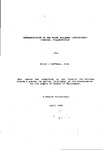OSMOREGULATION IN THE PRAWN PALAEMON LONGIROSTRIS (CARIDEA, PALAEMONIDAE)
| dc.contributor.author | CAMPBELL, PETER J | |
| dc.contributor.other | School of Biological and Marine Sciences | en_US |
| dc.date.accessioned | 2013-11-06T13:11:09Z | |
| dc.date.available | 2013-11-06T13:11:09Z | |
| dc.date.issued | 1988 | |
| dc.identifier | NOT AVAILABLE | en_US |
| dc.identifier.uri | http://hdl.handle.net/10026.1/2644 | |
| dc.description.abstract |
Salinity tolerance, and several aspects of osmoregulation, ionic regulation and permeability were measured for Palaemon longirostris at three temperatures (4, 12 & 20°C). Influence of ontogenetic stage on salinity tolerance and osmoregulation was investigated by testing separately individuals sorted, using carapace length, into 'small' (10-18mm), 'medium' (18-24mm), 'large' (>24mm) and 'ovigerous' (>24mm) size groupings. Effect of seasonal acclimatization on salinity tolerance and osmoregulation was taken into account by comparing responses of summer- with winter-collected prawns. Irrespective of temperature and size, summer Palaemon longirostris were extremely euryhaline and had >90% survival in various salinities from 0.5-34 º/oo . For summer prawns, survival in 43 º/oo was reduced, particularly at 4°C. Salinity tolerance of winter prawns was generally less than that of summer individuals, this difference being marked at salinity extremes in combination with low temperature. Over the salinity range 0.5-34 º/oo , prawns were very efficient hyper-hypo-osmoregulators at each temperature. At 43 º/oo, blood osmolalities tended towards the isosmotic, indicating that osmoregulation was breaking down. There was no clear effect of prawn size or season on osmoregulation, however, low temperature appeared to be disruptive. Transfer of prawns from 14 º/oo to either 5 º/oo or 34 º/oo, and from 1 º/oo to 34 º/oo, resulted in a new steady blood osmolality within 6-12h. Transfer from 34 º/oo to 1 º/oo , caused blood osmolality to drop significantly within 12h, and a new equilibrium was not reached until 72h. The inorganic ions sodium, chloride, potassium, calcium and magnesium accounted for >94% of total blood osmolality over the salinity range 0.5-34 º/oo . There was no consistent effect of temperature on the regulation of these ions. | en_US |
| dc.language.iso | en | en_US |
| dc.publisher | University of Plymouth | en_US |
| dc.title | OSMOREGULATION IN THE PRAWN PALAEMON LONGIROSTRIS (CARIDEA, PALAEMONIDAE) | en_US |
| dc.type | Thesis | en_US |
| plymouth.version | Full version: final and full version as approved by the examiners at the time of the award of your degree | en_US |
| dc.identifier.doi | http://dx.doi.org/10.24382/1294 | |
| dc.identifier.doi | http://dx.doi.org/10.24382/1294 |
Files in this item
This item appears in the following Collection(s)
-
01 Research Theses Main Collection
Research Theses Main


